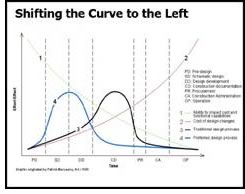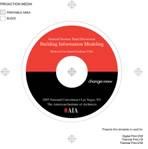

09/2005
by Norman Strong, FAIA
2006 AIA National Vice President
Partner, The Miller/Hull Partnership LLP
“If you want to survive, you’re going to change; if you don’t, you’re going to perish. It’s as simple as that.”—Thom Mayne, FAIA, 2005 Pritzker Prize Winner, during the Building Information Modeling Panel Discussion at the 2005 AIA national convention in Las Vegas.
 Less
than two years ago, I wouldn’t have believed the level of
change that the distinguished Building Information Modeling (BIM) Panel
at the AIA national convention described as inevitable was even close
to accurate. Owner-driven change? Building information modeling is the
key to our future? Survival? Perish? Those are some very strong words.
I prefer to think of architects as being presented with a significant
and positive opportunity: a new vision of practice and cooperation within
the construction industry. (Click photo for other panelist comments.)
Less
than two years ago, I wouldn’t have believed the level of
change that the distinguished Building Information Modeling (BIM) Panel
at the AIA national convention described as inevitable was even close
to accurate. Owner-driven change? Building information modeling is the
key to our future? Survival? Perish? Those are some very strong words.
I prefer to think of architects as being presented with a significant
and positive opportunity: a new vision of practice and cooperation within
the construction industry. (Click photo for other panelist comments.)
Technological evolution coupled with owner demand for better, faster, less costly construction projects and more effective processes are driving change in the construction industry in general and architecture practice in particular. Change that is revolutionary in nature . . . change that will transform practice as we know it today.
 During the panel discussion, held during the May 20 plenary session
at the AIA 2005 Convention in Las Vegas, some 2,000 architects heard
panelists discuss owners’ demand for change, a necessary shifting
of services, BIM, cross-discipline collaboration and interoperability,
and the use of technology in creation of strong design. I observed that
some members of the audience were excited, some were nervous, and some
were scared: It was clear that these emerging issues, among others, are
already making inroads into the architecture, engineering, construction,
and facility operations arenas. It was also clear that in short order
your practice—just like mine—will be dramatically affected.
It is important that you know that the AIA is aware of this and is acting
swiftly to implement initiatives to inform and empower members.
During the panel discussion, held during the May 20 plenary session
at the AIA 2005 Convention in Las Vegas, some 2,000 architects heard
panelists discuss owners’ demand for change, a necessary shifting
of services, BIM, cross-discipline collaboration and interoperability,
and the use of technology in creation of strong design. I observed that
some members of the audience were excited, some were nervous, and some
were scared: It was clear that these emerging issues, among others, are
already making inroads into the architecture, engineering, construction,
and facility operations arenas. It was also clear that in short order
your practice—just like mine—will be dramatically affected.
It is important that you know that the AIA is aware of this and is acting
swiftly to implement initiatives to inform and empower members.
Integrated
practice
During the convention, I was elected to serve as one of four AIA national
vice presidents in 2006. Since the election, next year’s president,
Kate Schwennsen, FAIA, tapped me to supplement the existing VP roles
focused on knowledge, community, and advocacy and focus on the important
emerging issue called “Integrated Practice” by the AIA.
Integrated Practice is an umbrella term intended to cover all issues
related to the new models of practice that even now are beginning to
be implemented. This new portfolio is the AIA’s most significant
initiative in this area, and I look forward to carrying the torch for
the Institute Integrated Practice initiative. The years 2006 and 2007
promise to be full of challenge and excitement . . . and change. I
am sure I will be calling on many of you for assistance and support.
In a similar direction of focus, I also am honored to serve as chair of the AIA’s Integrated Practice Strategy Working Group (IPSWG). Appointed by the Institute in March 2005 and composed of a range of industry leaders, owners, builders, legal/insurance representatives, educators, and software developers, the IPSWG is responsible for shaping a strategic vision for the future of practice and creating an action plan to get us there with implementation by the national AIA Board. The integrated-practice portfolio and IPSWG initiatives will build a positive foundation for future direction of practice for the Institute and its members. Informative component visits by Markku Allison, AIA, national staff resource architect; other IPSWG members; and me will happen in the near future, and a range of other events for 2006 are now in the planning stages.
Another major AIA initiative will be the sharing of the BIM panel discussion at the convention—through DVD format—with every AIA component in the country for use as a local component program. This is an exciting and compelling program (as I’m sure you can tell from the clip at the beginning of this article) that can serve as an excellent introduction to some of the topics you’ll be hearing lots about. Panelists included:
- William Tibbitt, representing the Construction Users Roundtable
- Patrick MacLeamy, AIA, CEO of HOK
- Philip Bernstein, FAIA, Autodesk
- Joseph Burns, PE, FAIA, Thornton-Tomasetti Group
- Thom Mayne, FAIA, Morphosis.
 Look for this DVD to arrive at your local chapter in September. Other
materials will be made available as relevant events occur.
Look for this DVD to arrive at your local chapter in September. Other
materials will be made available as relevant events occur.
A series of articles to come
To bring all our members and construction industry partners up to speed
on the most current concepts relating to integrated practice, a series
of articles, which this one introduces, will be our most visible and
accessible initiative and communication tool. Over the next weeks and
months, it will provoke you, educate you, challenge you, and serve
as a resource and as a learning tool for you and your firm.
Content of the series will be wide-ranging, from BIM basics to new business models, from interoperability to office culture, from software criteria to 4D modeling, and more. We will draw on a pool of leaders as well as everyday practitioners from the worlds of architecture, construction, facilities management, risk management, law, and academia. Watch future issues of AIArchitect for the “changeisnow” logo and check out the articles. As we move forward, material from the series will become resource material and migrate to a permanent home on a new highlighted section of the Practice of Architecture page on the AIA Web site.
My work with the AIA regarding issues of project delivery, BIM, interoperability, and integrated practice over the last couple of years has convinced me: This change is real and it is already here.
This revolution is already changing my firm, and it will change yours—big firms and small firms alike. Actually, small firms are using the software more prevalently than the big ones, so this is definitely not just a big firm/big project issue. And although BIM is an enabler, it’s decidedly not just about BIM—it’s a cultural shift that will touch everything we do. Our profession will be utterly different, transformed, within the next 5–10 years.
Recognizing this as an inevitable outcome—and more importantly, as a significant design opportunity—my firm has embraced this new direction. We have just purchased a number of seats of BIM-capable software and are embarking on a new journey. Some of you are already ahead of us and have been addressing these issues in some form or another for some time. But the majority of practicing architects have not.
We need to move quickly. We have before us a tremendous opportunity to reverse our late adoption tendencies and move forward in a very positive way: let’s embrace, demand, accelerate, and implement change . . . now.
Copyright 2005 The American Institute of Architects.
All rights reserved. Home Page ![]()
![]()
 |
||
The next changeisnow, authored by Philip G. Bernstein, FAIA, vice president, Autodesk Building Industry division, will examine how the coming change is about much, much more than the technology. If you have questions about what the AIA is doing about BIM, integrated practice, interoperability, or other related topics, contact Markku Allison, AIA, 202-626-7487 or changeisnow@aia.org. What is integrated practice? At the core of an integrated practice are fully collaborative, highly integrated, and productive teams composed of all project life-cycle stakeholders. Leveraging early the contributions of individual expertise, these teams will be guided by principles of true collaboration, open information sharing, team success tied to project success, shared risk and reward, value-based decision making, and utilization of full technological capabilities and support. The outcome will be the opportunity to design, build, and operate as efficiently as possible.
|
||